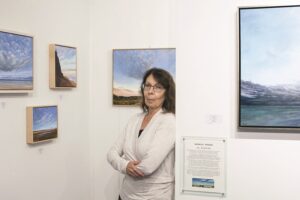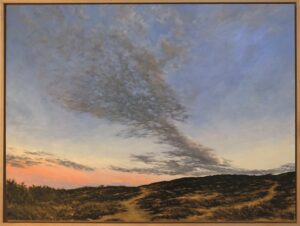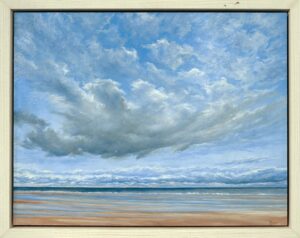Monica Rozak often walks along the bluff by Marconi Beach when the sun is coming up or going down. “I’m really drawn to the sky,” she says.

Her landscape paintings, on view at Burdick Gallery in Wellfleet and Weekend in Orleans, reflect her experience of observing the landscape and looking upward at light sifting through moving clouds. It took her years of walking through the landscape, however, before she began to translate her observations into paintings. “I absorbed Cape Cod for 20 years before I started to paint,” says Rozak.
In one painting, By Chance, she looks up at clouds hovering above the gentle crest of a dune at twilight. Originating from a compact line on the horizon, the clouds disperse upward, breaking into small bits and fanning out into the expansive sky at the top of the composition. She renders the clouds with small stippled marks, touching her surface with an energy akin to the soft, kinetic presence of a cloud in the sky.
There’s a synchronism here between her touch and her subject. In a similar manner, her imagery of shifting light and fleeting clouds reflects the internal urgency that led her to painting.
“I started painting seven years ago, although I wanted to paint since the age of seven,” says Rozak. “I’m not sure why I was afraid to start sooner,” she says. She mentions perfectionism and busyness. As a shy child growing up in the Buffalo suburbs, she “lived” in her sketchbook. “It was my way of communicating,” says Rozak.
When it was time to go to college she was accepted to art school at Pratt Institute in Brooklyn but ended up at Marymount College. “I was a good Catholic girl and did what my mother wanted,” says Rozak. Nonetheless, she found space for creativity in fiber art and printmaking and through her work as a commercial artist in New York City after college. In 1986 she moved to West Dennis to manage a hotel, the Marina Bay, before settling first in East Orleans and then Eastham. Yet painting continued to elude her.

“I allowed other things to get in the way,” says Rozak. “I hit 50, and I thought I can’t keep wanting something and not doing something about it.”
Determined not to let this dream drift away, Rozak took a class with Rick Fleury in his Eastham studio. “It opened a door,” says Rozak. It also came at the right moment: with her stepchildren grown up and out of the house, she had more time and space for art. “Things happen when they’re meant to,” she says. “I started something and kept it going. I’m grateful to be on this path after so much time and so many other things that I’ve done in my life.”
Rozak hopes that her paintings allow others to reflect on their own existence and life choices. “A painting captures such a fleeting moment,” she says. “It is gone in a flash. You can take that and look at how fast our lives go by. I want most of my paintings to be about the experience of solitude when you go into your own heart and soul and really look at the truth of who you are and where you are on this planet and what you’re doing with your life.”
This existential quest is perhaps best encapsulated in her painting Fragile, which depicts a curve of land that Rozak observed while walking in Provincetown. Although she doesn’t typically paint human figures, she inserted a small figure — just a speck of paint — on the sliver of sand jutting into a dark and ominous body of water. Black clouds hug the horizon. The figure is vulnerable, threatened by the possibility of an approaching storm and incoming tide. Yet the painting is not without hope. Blue skies and illuminated clouds emerge from under the darkness, dominating the top two-thirds of the painting. The figure is caught in a drama with the external landscape mirroring an internal, spiritual experience. Visually and conceptually, the piece has roots in Romanticism and recalls Caspar David Friedrich’s mystical paintings of lone figures in sublime landscapes.

“We all go through hard times, whether they’re as big as a worldwide pandemic or a financial struggle or finding a home on Cape Cod,” says Rozak. “We all have challenges we’re going to have to face, and we get through them and move on.” Rozak made this painting during the pandemic, although she didn’t see the association with the image until later. It was also informed by an aphorism her mother often repeated: “It’s darkest before the dawn.”
“As a child I would think too much or have too much anxiety about school,” says Rozak. “She would comfort us by saying this.”
Other paintings are less dramatic. In Wind and Water, a large cloud hangs above the Atlantic Ocean. It’s a buoyant image with its summery blues and calm water, but here, too, Rozak creates tension (although to a less operatic effect) through layering dark colors, like the murky gray of the clouds, over lighter colors. In doing so, the painting achieves a luminescent quality. The low vantage point of the viewer with the sky stretching overhead also positions the human presence in subordination to the landscape, which is one reason Rozak enjoys painting the sky so much.
“The sky makes me feel like a small part of this Earth and experience how wonderful the world is,” she says. “The ocean does it for others, but I’m really drawn to the sky. We’re all kind of significant and insignificant. We’re all this tiny part of the whole.”



